Additive Manufacturing of Anatomical Poly(d,l-lactide) Scaffolds
Abstract
1. Introduction
2. Materials and Methods
2.1. Materials
2.2. Additive Manufacturing
2.3. Scanning Electron Microscopy (SEM)
2.4. Proton Nuclear Magnetic Resonance (1H-NMR)
2.5. Size Exclusion Chromatography (SEC)
2.6. Thermogravimetric Analysis (TGA)
2.7. Differential Scanning Calorimetry (DSC)
2.8. Mechanical Characterization
2.9. Statistical Analysis
3. Results and Discussion
3.1. Digital Modelling and Fabrication
3.2. Morphological Characterization
3.3. Physical-Chemical Characterization
3.4. Thermal Characterization
3.5. Mechanical Characterization
4. Conclusions
Author Contributions
Funding
Institutional Review Board Statement
Informed Consent Statement
Data Availability Statement
Acknowledgments
Conflicts of Interest
References
- Ahmed, J.; Varshney, S.K. Polylactides—Chemistry, Properties and Green Packaging Technology: A Review. Int. J. Food Prop. 2011, 14, 37–58. [Google Scholar] [CrossRef]
- Datta, R.; Henry, M. Lactic acid: Recent advances in products, processes and technologies—A review. J. Chem. Technol. Biotechnol. 2006, 81, 1119–1129. [Google Scholar] [CrossRef]
- Freeland, B.; Mc Carthy, E.; Balakrishnan, R.; Fahy, S.; Boland, A.; Rochfort, K.D.; Dabros, M.; Marti, R.; Kelleher, S.M.; Gaughran, J.A. Review of Polylactic Acid as a Replacement Material for Single-Use Laboratory Components. Materials 2022, 15, 2989. [Google Scholar] [CrossRef] [PubMed]
- Mano, J.F.; Gómez Ribelles, J.L.; Alves, N.M.; Salmerón Sanchez, M. Glass transition dynamics and structural relaxation of PLLA studied by DSC: Influence of crystallinity. Polymer 2005, 46, 8258–8265. [Google Scholar] [CrossRef]
- Narladkar, A.; Balnois, E.; Vignaud, G.; Grohens, Y. Difference in Glass Transition Behavior Between Semi Crystalline and Amorphous poly(lactic acid) Thin Films. Macromol. Symp. 2008, 273, 146–152. [Google Scholar] [CrossRef]
- An, Y.H.; Woolf, S.K.; Friedman, R.J. Pre-clinical in vivo evaluation of orthopaedic bioabsorbable devices. Biomaterials 2000, 21, 2635–2652. [Google Scholar] [CrossRef]
- Barber, F.A.; Dockery, W.D. Long-Term Absorption of Poly-l-Lactic Acid Interference Screws. Arthrosc. J. Arthrosc. Relat. Surg. 2006, 22, 820–826. [Google Scholar] [CrossRef]
- Warden, W.H.; Chooljian, D.; Jackson, D.W. Ten-Year Magnetic Resonance Imaging Follow-Up of Bioabsorbable Poly-l-Lactic Acid Interference Screws After Anterior Cruciate Ligament Reconstruction. Arthrosc. J. Arthrosc. Relat. Surg. 2008, 24, 370.e371–370.e373. [Google Scholar] [CrossRef]
- Annunziata, M.; Nastri, L.; Cecoro, G.; Guida, L. The Use of Poly-d l-lactic Acid Devices for Bone Augmentation Techniques A. Systematic Review. Molecules 2017, 22, 2214. [Google Scholar] [CrossRef]
- Doppalapudi, S.; Jain, A.; Khan, W.; Domb, A.J. Biodegradable polymers—An overview. Polym. Adv. Technol. 2014, 25, 427–435. [Google Scholar] [CrossRef]
- Narayanan, G.; Vernekar, V.N.; Kuyinu, E.L.; Laurencin, C.T. Poly (lactic acid)-based biomaterials for orthopaedic regenerative engineering. Adv. Drug Deliv. Rev. 2016, 107, 247–276. [Google Scholar] [CrossRef] [PubMed]
- Alexy, R.D.; Levi, D.S. Materials and Manufacturing Technologies Available for Production of a Pediatric Bioabsorbable Stent. BioMed Res. Int. 2013, 2013, 137985. [Google Scholar] [CrossRef] [PubMed]
- Rezwan, K.; Chen, Q.Z.; Blaker, J.J.; Boccaccini, A.R. Biodegradable and bioactive porous polymer/inorganic composite scaffolds for bone tissue engineering. Biomaterials 2006, 27, 3413–3431. [Google Scholar] [CrossRef]
- Puppi, D.; Chiellini, F. Biodegradable Polymers for Biomedical Additive Manufacturing. Appl. Mater. Today 2020, 20, 100700. [Google Scholar] [CrossRef]
- ISO/ASTM 52900; Additive Manufacturing General Principles—Fundamentals and Vocabulary. ISO: Geneva, Switzerland, 2021.
- Xiong, Z.; Yan, Y.; Zhang, R.; Sun, L. Fabrication of porous poly(l-lactic acid) scaffolds for bone tissue engineering via precise extrusion. Scr. Mater. 2001, 45, 773–779. [Google Scholar] [CrossRef]
- Lee, C.H.; Padzil, F.N.B.M.; Lee, S.H.; Ainun, Z.M.A.; Abdullah, L.C. Potential for Natural Fiber Reinforcement in PLA Polymer Filaments for Fused Deposition Modeling Additive Manufacturing: A Review. Polymers 2021, 13, 1407. [Google Scholar] [CrossRef] [PubMed]
- Ilyas, R.A.; Sapuan, S.M.; Harussani, M.M.; Hakimi, M.Y.A.Y.; Haziq, M.Z.M.; Atikah, M.S.N.; Asyraf, M.R.M.; Ishak, M.R.; Razman, M.R.; Nurazzi, N.M.; et al. Polylactic Acid (PLA) Biocomposite: Processing, Additive Manufacturing and Advanced Applications. Polymers 2021, 13, 1326. [Google Scholar] [CrossRef] [PubMed]
- Ranjan, N.; Singh, R.; Ahuja, I.P.S. Material Processing of PLA-HAp-CS-Based Thermoplastic Composite Through Fused Deposition Modeling for Biomedical Applications. In Biomanufacturing; Prakash, C., Singh, S., Singh, R., Ramakrishna, S., Pabla, B.S., Puri, S., Uddin, M.S., Eds.; Springer International Publishing: Cham, Switzerland, 2019; pp. 123–136. [Google Scholar]
- Wang, Q.; Ji, C.; Sun, L.; Sun, J.; Liu, J. Cellulose nanofibrils filled poly (lactic acid) biocomposite filament for FDM 3D printing. Molecules. Molecules 2020, 25, 2319. [Google Scholar] [CrossRef]
- Zhang, H.; Mao, X.; Zhao, D.; Jiang, W.; Du, Z.; Li, Q.; Jiang, C.; Han, D. Three dimensional printed polylactic acid-hydroxyapatite composite scaffolds for prefabricating vascularized tissue engineered bone: An in vivo bioreactor model. Sci. Rep. 2017, 7, 15255. [Google Scholar] [CrossRef]
- Fairag, R.; Rosenzweig, D.H.; Ramirez-Garcialuna, J.L.; Weber, M.H.; Haglund, L. Three-Dimensional Printed Polylactic Acid Scaffolds Promote Bone-like Matrix Deposition in Vitro. ACS Appl. Mater. Interfaces 2019, 11, 15306–15315. [Google Scholar] [CrossRef]
- Chhaya, M.P.; Melchels, F.P.W.; Holzapfel, B.M.; Baldwin, J.G.; Hutmacher, D.W. Sustained regeneration of high-volume adipose tissue for breast reconstruction using computer aided design and biomanufacturing. Biomaterials 2015, 52, 551–560. [Google Scholar] [CrossRef]
- Boetker, J.; Water, J.J.; Aho, J.; Arnfast, L.; Bohr, A.; Rantanen, J. Modifying release characteristics from 3D printed drug-eluting products. Eur. J. Pharm. Sci. 2016, 90, 47–52. [Google Scholar] [CrossRef]
- Pantani, R.; Sorrentino, A. Influence of crystallinity on the biodegradation rate of injection-moulded poly(lactic acid) samples in controlled composting conditions. Polym. Degrad. Stab. 2013, 98, 1089–1096. [Google Scholar] [CrossRef]
- Brdlík, P.; Borůvka, M.; Běhálek, L.; Lenfeld, P. Biodegradation of Poly Biocomposites under Controlled Composting Conditions Freshwater Biotope. Polymers 2021, 13, 594. [Google Scholar] [CrossRef]
- Pecorini, G.; Braccini, S.; Parrini, G.; Chiellini, F.; Puppi, D. Additive Manufacturing of Poly(3-hydroxybutyrate-co-3-hydroxyvalerate)/Poly(d,l-lactide-co-glycolide) Biphasic Scaffolds for Bone Tissue Regeneration. Int. J. Mol. Sci. 2022, 23, 3895. [Google Scholar] [CrossRef]
- Puppi, D.; Chiellini, F. Computer-Aided Wet-Spinning. In Computer-Aided Tissue Engineering: Methods and Protocols; Rainer, A., Moroni, L., Eds.; Springer: New York, NY, USA, 2021; pp. 101–110. [Google Scholar]
- Auras, R.; Harte, B.; Selke, S. An overview of polylactides as packaging materials. Macromol. Biosci. 2004, 4, 835–864. [Google Scholar] [CrossRef]
- ASTM D1708; Standard Test Method for Tensile Properties of Plastics by Use of Microtensile Specimens. ASTM: West Conshohocken, PA, USA, 1993.
- ASTM D 882; Standard Test Methods for Tensile Properties of Thin Plastic Sheeting. ASTM: West Conshohocken, PA, USA, 1991.
- Heshmat, M.; Abdelrhman, Y. Improving surface roughness of polylactic acid (PLA) products manufactured by 3D printing using a novel slurry impact technique. Rapid Prototyp. J. 2021, 27, 1791–1800. [Google Scholar] [CrossRef]
- Buj-Corral, I.; Sánchez-Casas, X.; Luis-Pérez, C.J. Analysis of AM parameters on surface roughness obtained in PLA parts printed with FFF technology. Polymers 2021, 13, 2384. [Google Scholar] [CrossRef]
- Jayanth, N.; Senthil, P.; Prakash, C. Effect of chemical treatment on tensile strength and surface roughness of 3D-printed ABS using the FDM process. Virtual Phys. Prototyp. 2018, 13, 155–163. [Google Scholar] [CrossRef]
- Zareidoost, A.; Yousefpour, M.; Ghaseme, B.; Amanzadeh, A. The relationship of surface roughness and cell response of chemical surface modification of titanium. J. Mater. Sci. Mater. Med. 2012, 23, 1479–1488. [Google Scholar] [CrossRef]
- Cai, S.; Wu, C.; Yang, W.; Liang, W.; Yu, H.; Liu, L. Recent advance in surface modification for regulating cell adhesion and behaviors. Nanotechnol. Rev. 2020, 9, 971–989. [Google Scholar] [CrossRef]
- Zell, M.; Padden, B.; Paterick, A.; Thakur, K.; Kean, R.; Hillmyer, M.; Munson, E. Unambiguous Determination of the 13C and 1H NMR Stereosequence Assignments of Polylactide Using High-Resolution Solution NMR Spectroscopy. Macromolecules 2002, 35, 7700–7707. [Google Scholar] [CrossRef]
- Wu, L.; Park, J.; Kamaki, Y.; Kim, B. Optimization of the fused deposition modeling-based fabrication process for polylactic acid microneedles. Microsyst. Nanoeng. 2021, 7, 58. [Google Scholar] [CrossRef]
- Carrasco, F.; Pagès, P.; Gámez-Pérez, J.; Santana, O.O.; Maspoch, M.L. Processing of poly(lactic acid): Characterization of chemical structure, thermal stability and mechanical properties. Polym. Degrad. Stab. 2010, 95, 116–125. [Google Scholar] [CrossRef]
- Yousfi, M.; Belhadj, A.; Lamnawar, K.; Maazouz, A. 3D printing of PLA and PMMA multilayered model polymers: An innovative approach for a better-controlled pellet multi-extrusion process. In Proceedings of the ESAFORM 2021, University of Liège, Belgium, digital event. 14–16 April 2021. [Google Scholar]
- Pires, M.; Murariu, M.; Cardoso, A.M.; Bonnaud, L.; Dubois, P. Thermal degradation of poly(lactic acid)–zeolite composites produced by melt-blending. Polym. Bull. 2019, 77, 2111–2137. [Google Scholar] [CrossRef]
- Hedenqvist, M.S. Barrier Packaging Materials. In Handbook of Environmental Degradation of Materials; Kutz, M., Ed.; Elsevier: Amsterdam, The Netherlands, 2012; pp. 833–862. [Google Scholar]
- Sasaki, T.; Yamauchi, N.; Irie, S.; Sakurai, K. Differential scanning calorimetry study on thermal behaviors of freeze-dried poly(l-lactide) from dilute solutions. J. Polym. Sci. Part B Polym. Phys. 2005, 43, 115–124. [Google Scholar] [CrossRef]
- Ghodbane, S.A.; Murthy, N.S.; Dunn, M.G.; Kohn, J. Achieving molecular orientation in thermally extruded 3D printed objects. Biofabrication 2019, 11, 045004. [Google Scholar] [CrossRef]
- Drummer, D.; Cifuentes-Cuéllar, S.; Rietzel, D. Suitability of PLA/TCP for fused deposition modeling. Rapid Prototyp. J. 2012, 18, 500–507. [Google Scholar] [CrossRef]
- Pecorini, G.; Chiellini, F.; Puppi, D. Mechanical Characterization of Additive Manufactured Polymeric Scaffolds for Tissue Engineering. In Biomimetic Biomaterials for Tissue Regeneration and Drug Delivery; Dash, M., Ed.; Springer: Singapore, 2022; pp. 99–148. [Google Scholar]
- Lanzotti, A.; Grasso, M.; Staiano, G.; Martorelli, M. The impact of process parameters on mechanical properties of parts fabricated in PLA with an open-source 3-D printer. Rapid Prototyp. J. 2015, 21, 604–617. [Google Scholar] [CrossRef]
- Chacón, J.M.; Caminero, M.A.; García-Plaza, E.; Núñez, P.J. Additive manufacturing of PLA structures using fused deposition modelling: Effect of process parameters on mechanical properties and their optimal selection. Mater. Des. 2017, 124, 143–157. [Google Scholar] [CrossRef]
- Cojocaru, V.; Frunzaverde, D.; Miclosina, C.-O.; Marginean, G. The Influence of the Process Parameters on the Mechanical Properties of PLA Specimens Produced by Fused Filament Fabrication—A Review. Polymers 2022, 14, 886. [Google Scholar] [CrossRef] [PubMed]
- Maguluri, N.; Suresh, G.; Rao, K.V. Assessing the effect of FDM processing parameters on mechanical properties of PLA parts using Taguchi method. J. Thermoplast. Compos. Mater. 2021, 08927057211053036. [Google Scholar] [CrossRef]
- Puppi, D.; Pecorini, G.; Chiellini, F. Biomedical Processing of Polyhydroxyalkanoates. Bioengineering 2019, 6, 108. [Google Scholar] [CrossRef]
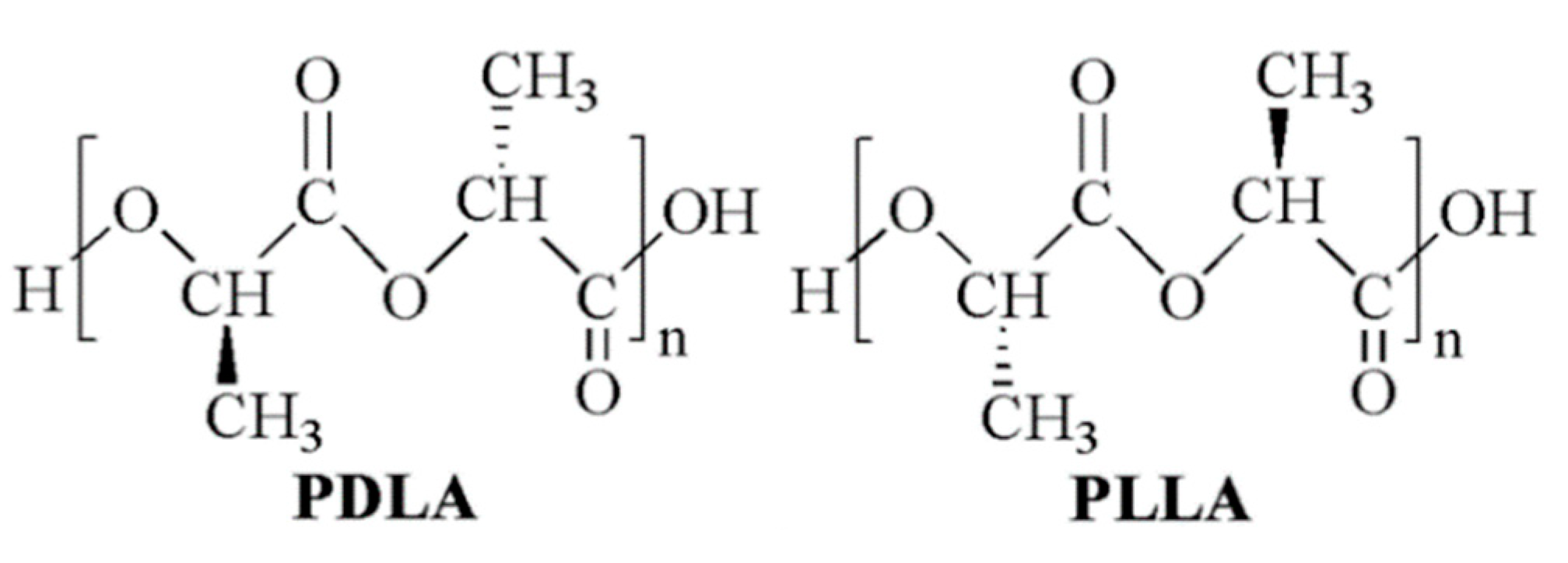
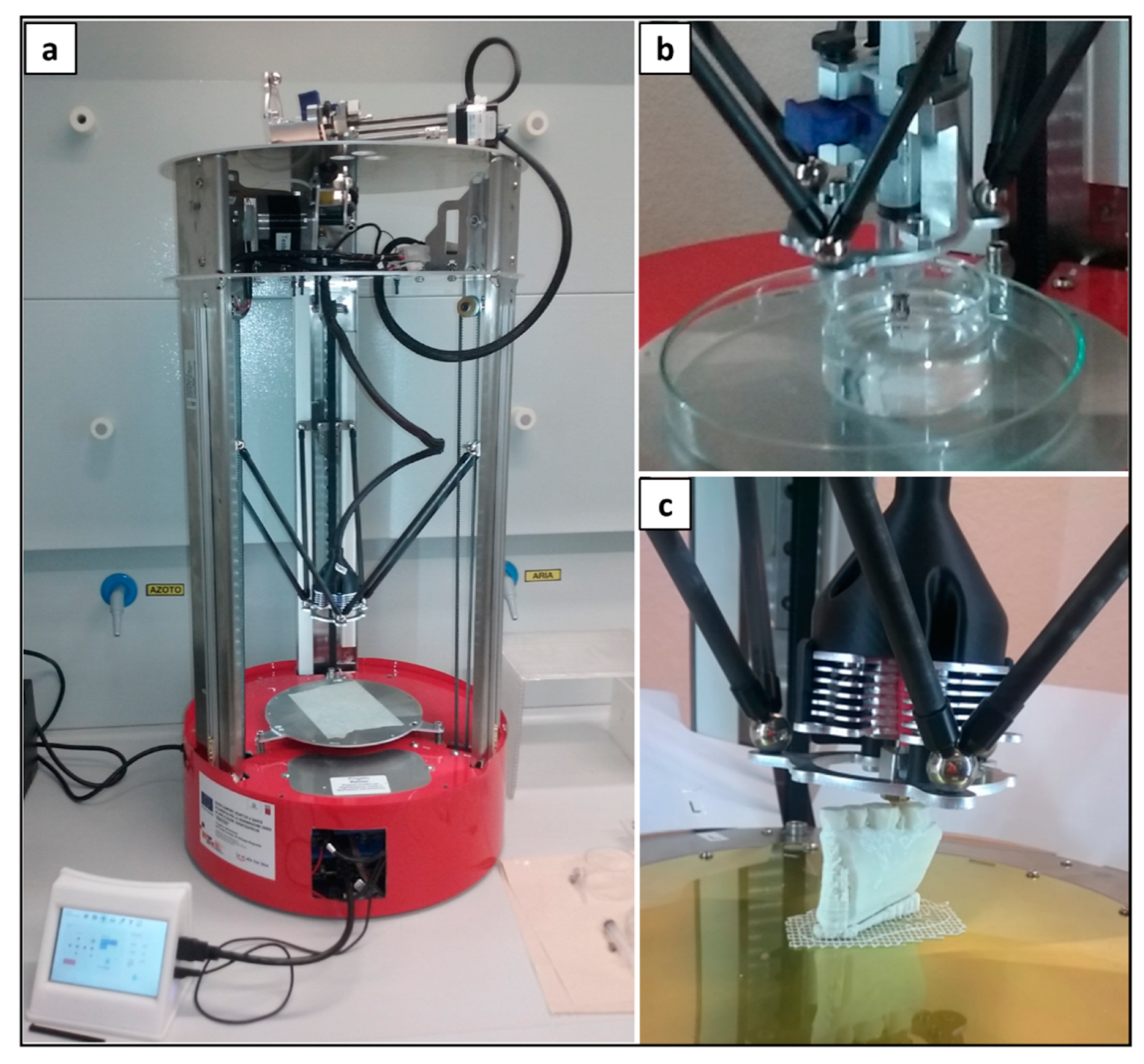
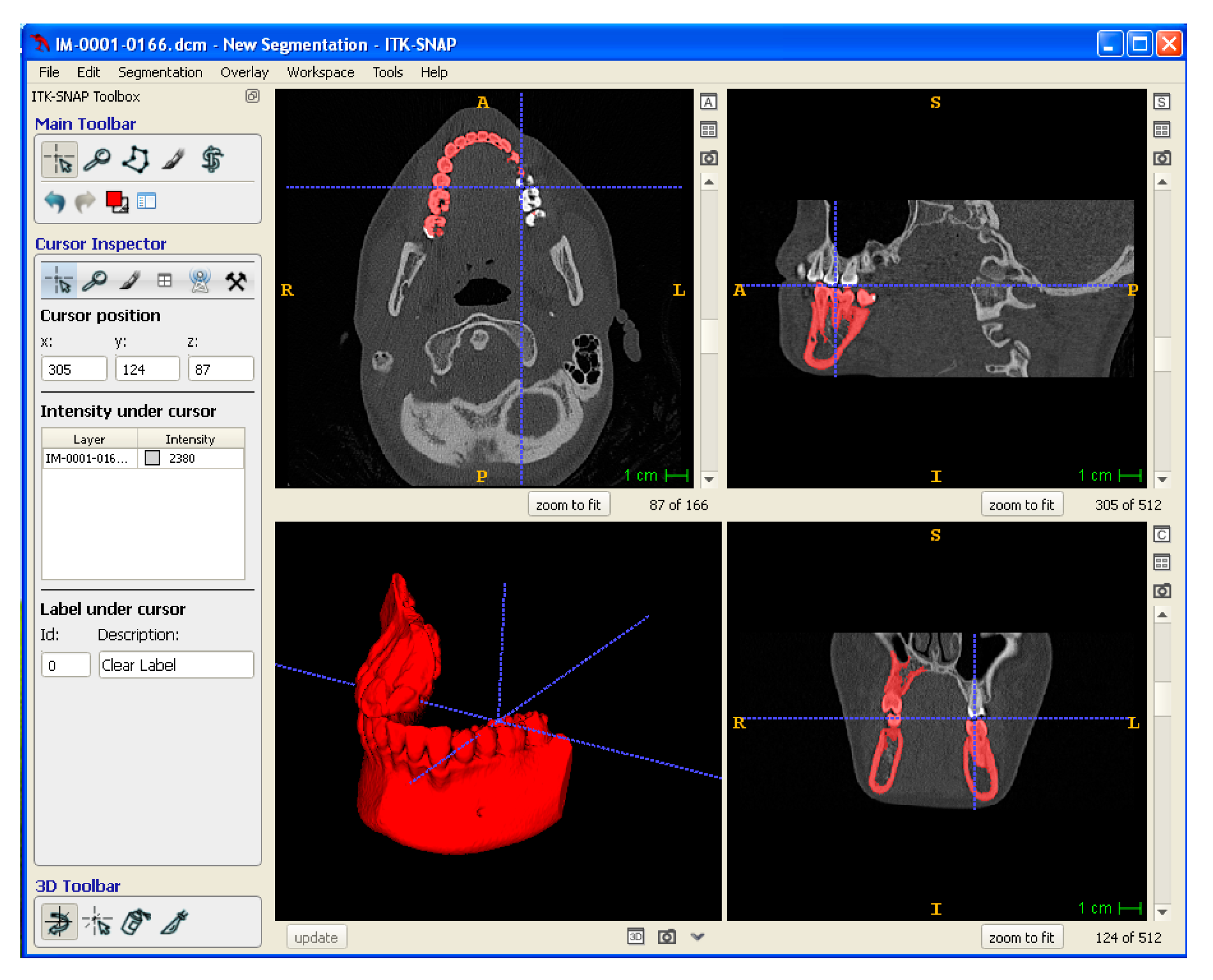


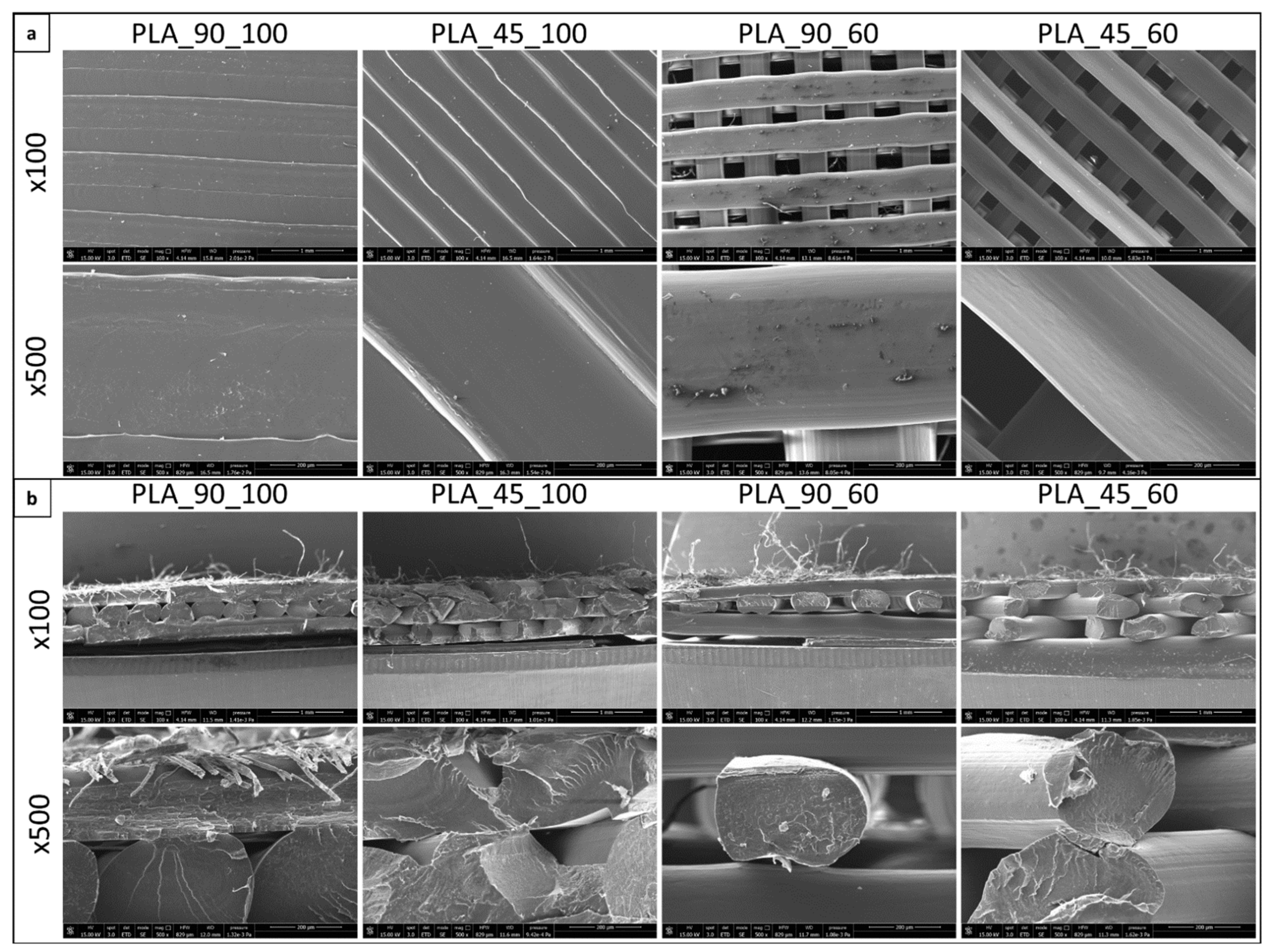
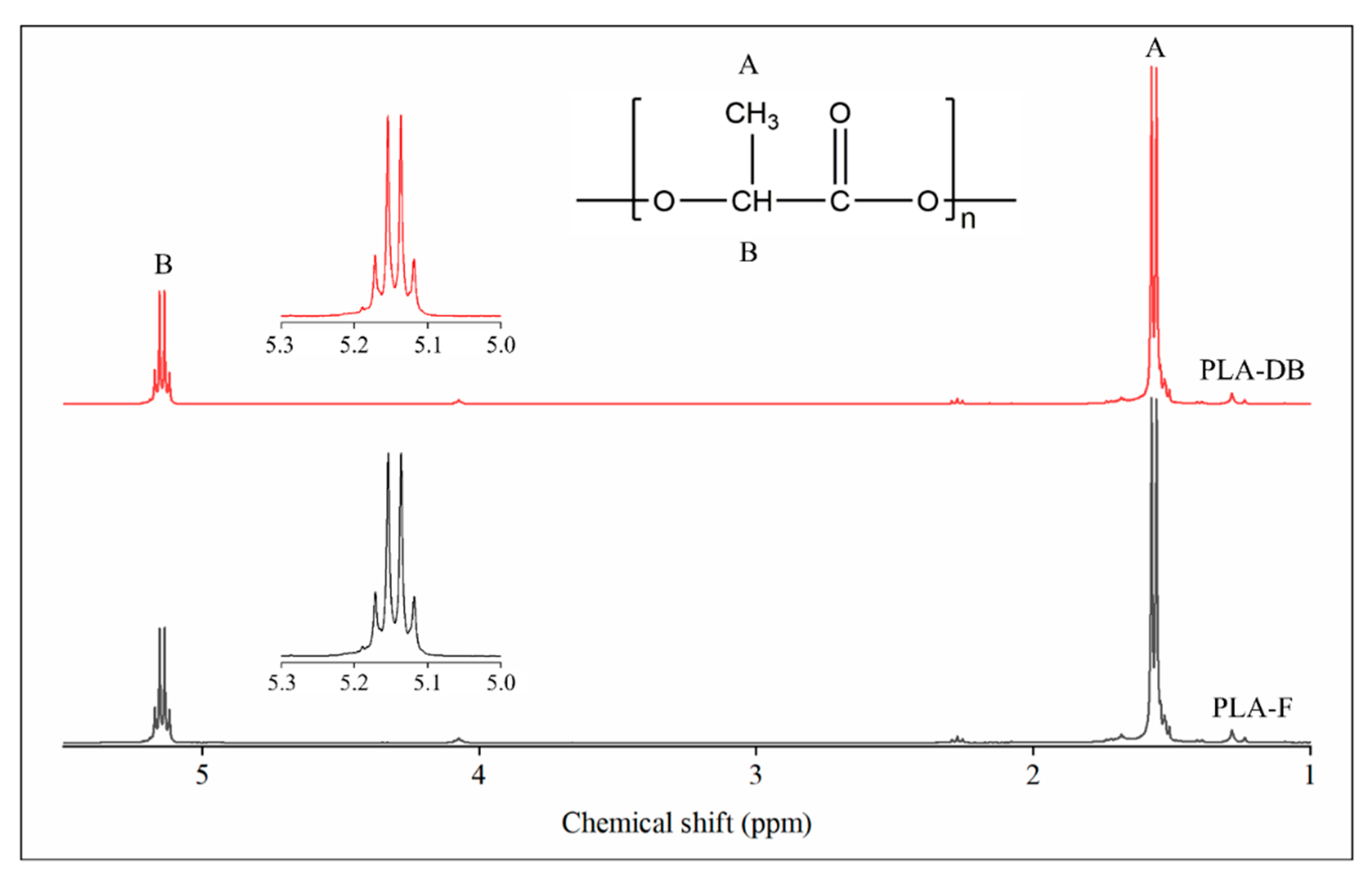

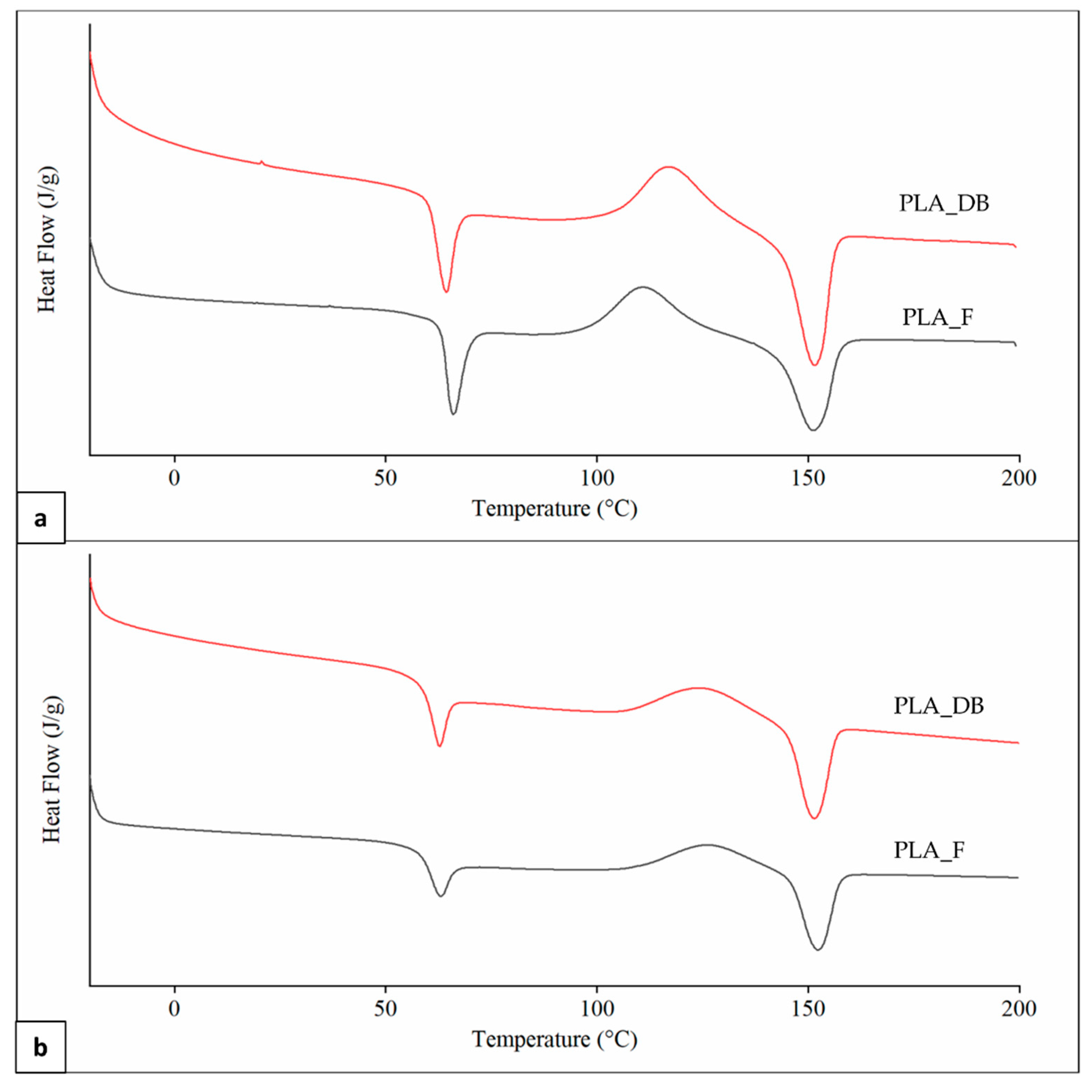
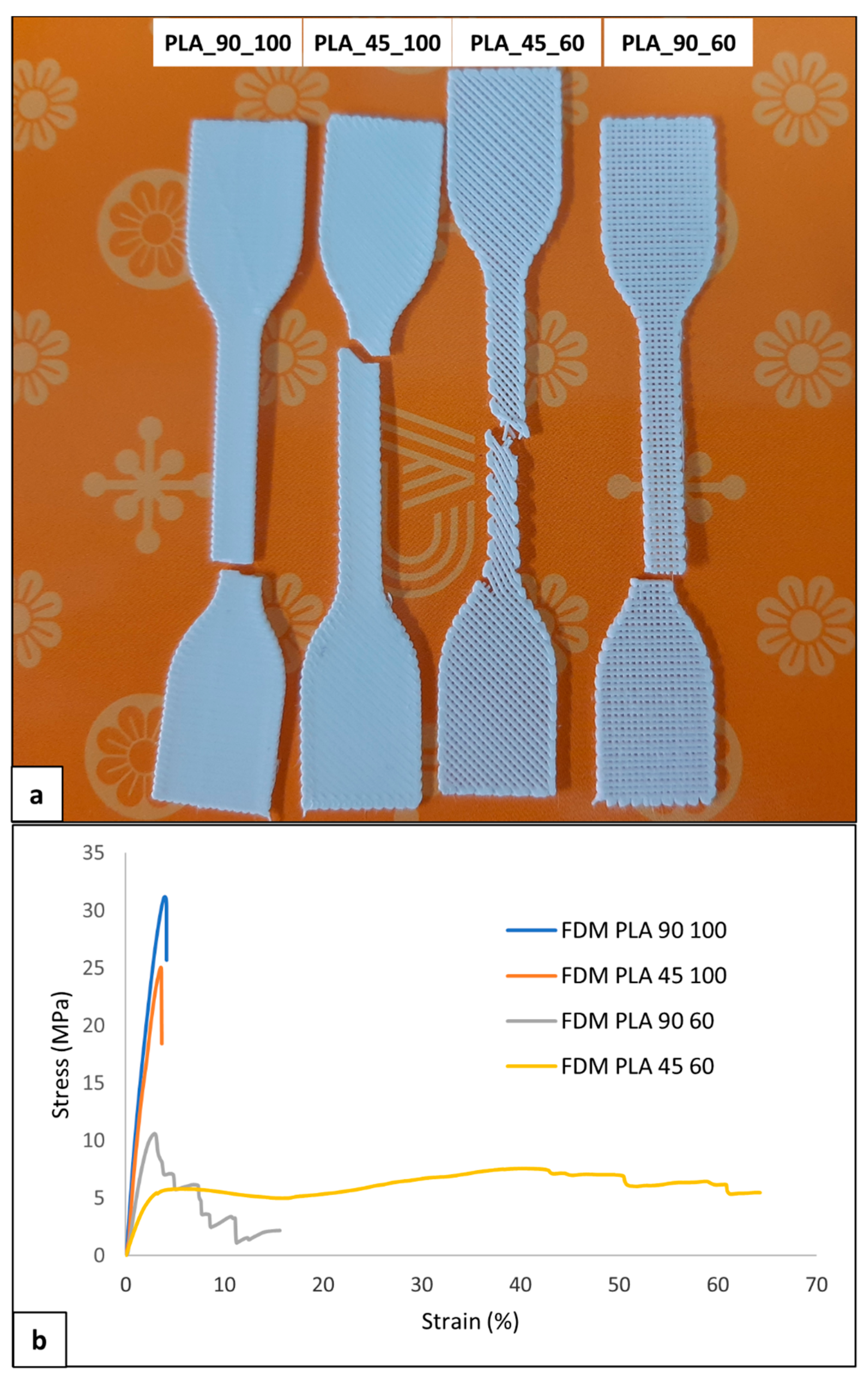
| Parameter | Optimized Value |
|---|---|
| Infill angle | 90° or 45° |
| Infill density | 60 or 100% |
| Nozzle diameter | 400 μm |
| Layer height (dZ) | 300 μm |
| Infill speed | 10 mm/s |
| Extruder T | 210 °C |
| Bed T | 40 °C |
| Sample | Ra (μm) |
|---|---|
| PLA_90_100 | 1.95 ± 0.30 a |
| PLA_45_100 | 4.59 ± 0.65 * |
| PLA_90_60 | 6.13 ± 0.80 |
| PLA_45_60 | 6.67 ± 0.97 * |
| Sample | Mn (g/mol) | Mw (g/mol) | PI |
|---|---|---|---|
| PLA_F | 86,600 ± 400 * | 124,600 ± 500 ** | 1.439 ± 0.001 *** |
| PLA_DB | 83,000 ± 300 * | 118,000 ± 500 ** | 1.422 ± 0.002 *** |
| Tonset (°C) | Tmax (°C) | |
|---|---|---|
| PLA_F | 350.1 ± 0.4 * | 372.4 ± 0.1 ** |
| PLA_DB | 346.9 ± 0.5 * | 369.8 ± 0.4 ** |
| Sample | Tg (°C) | Tcc (°C) | ΔHcc (J/g) | Tm (°C) | χ (%) | |
|---|---|---|---|---|---|---|
| First heating | PLA_F | 64.3 ± 0.2 a | 110.7 ± 0.4 a | 21.4 ± 2.0 * | 150.9 ± 0.2 | 28.6 ± 0.6 * |
| PLA_DB | 62.0 ± 0.3 a | 117.3 ± 0.8 a | 22.8 ± 2.0 * | 151.5 ± 0.5 | 27.9 ± 2.5 * | |
| Second heating | PLA_F | 61.0 ± 0.2 * | 126.6 ± 0.5 * | 10.5 ± 0.8 ** | 151.9 ± 1.0 | 14.0 ± 0.5 ** |
| PLA_DB | 60.9 ± 0.6 * | 126.2 ± 1.9 * | 10.7 ± 0.9 ** | 151.6 ± 0.3 | 13.0 ± 2.6 ** |
| Sample | E (GPa) | σmax (MPa) | εbreak (%) |
|---|---|---|---|
| PLA_90_100 | 1.3 ± 0.1 * | 33.1 ± 3.4 * | 4.1 ± 0.6 |
| PLA_45_100 | 1.1 ± 0.2 * | 32.6 ± 8.5 * | 4.9 ± 0.9 |
| PLA_90_60 | 0.5 ± 0.1 ** | 9.6 ± 1.1 ** | 11.2 ± 4.6 |
| PLA_45_60 | 0.3 ± 0.1 ** | 8.0 ± 1.4 ** | 68.2 ± 15.1 a |
Publisher’s Note: MDPI stays neutral with regard to jurisdictional claims in published maps and institutional affiliations. |
© 2022 by the authors. Licensee MDPI, Basel, Switzerland. This article is an open access article distributed under the terms and conditions of the Creative Commons Attribution (CC BY) license (https://creativecommons.org/licenses/by/4.0/).
Share and Cite
Puppi, D.; Pecorini, G.; Parrini, G. Additive Manufacturing of Anatomical Poly(d,l-lactide) Scaffolds. Polymers 2022, 14, 4057. https://doi.org/10.3390/polym14194057
Puppi D, Pecorini G, Parrini G. Additive Manufacturing of Anatomical Poly(d,l-lactide) Scaffolds. Polymers. 2022; 14(19):4057. https://doi.org/10.3390/polym14194057
Chicago/Turabian StylePuppi, Dario, Gianni Pecorini, and Gianluca Parrini. 2022. "Additive Manufacturing of Anatomical Poly(d,l-lactide) Scaffolds" Polymers 14, no. 19: 4057. https://doi.org/10.3390/polym14194057
APA StylePuppi, D., Pecorini, G., & Parrini, G. (2022). Additive Manufacturing of Anatomical Poly(d,l-lactide) Scaffolds. Polymers, 14(19), 4057. https://doi.org/10.3390/polym14194057








